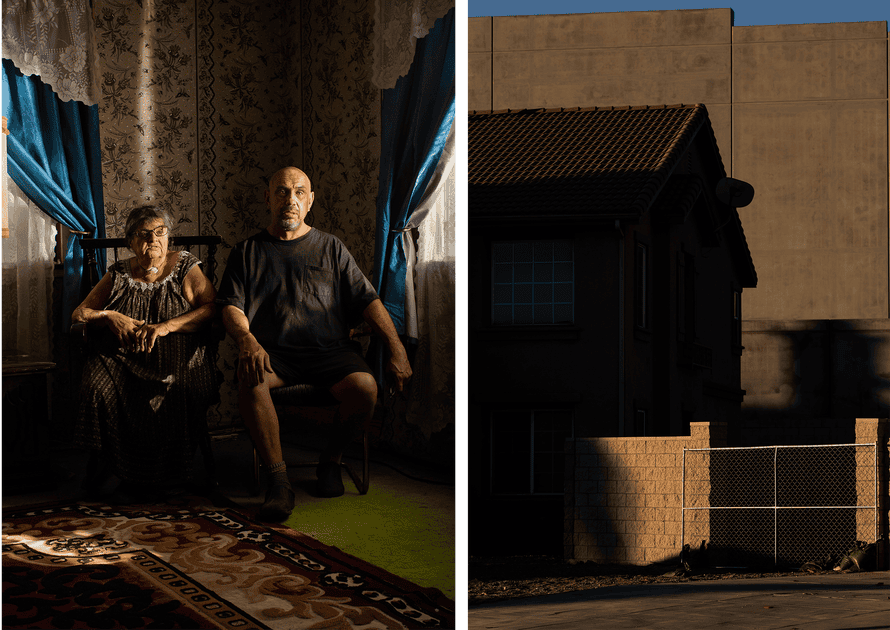‘Pollution everywhere’: how one-click shopping is creating Amazon warehouse towns
Three generations of Arah Parker’s family have lived in her pleasant, yellow-hued home, where there used to be a clear view of the San Gabriel mountains from the kitchen window.
There used to be – until the country’s hunger for online shopping swallowed the neighborhood.
Four massive Amazon warehouses – ranging from 500,000 to nearly 900,000 sq ft – now surround this historically Black community, as do distribution centers for Target, Under Armour, Monster Energy and Keeco textiles. Her home is now boxed in on three sides by concrete block buildings and the quiet road out front has been paved into a four-lane expressway rumbling with delivery trucks.
To feed the one-click, one-day delivery demands of the nation, new warehouses are opening quickly, often in Black and brown neighborhoods. They sometimes chew up entire suburban blocks and communities in the process, crowding roadways with delivery trucks and vans and air space with cargo planes, clouding the air with more pollution.
Located about 60 miles east of Los Angeles, the Inland Empire has the third-largest concentration of Amazon warehouses in the US, according to a database of Amazon facilities Consumer Reports (CR) purchased from MWPVL, a logistics consulting firm.

Right: A warehouse wall erected behind a strip of homes on Sugar Lane in Fontana, California. Photograph: Alex Welsh/The Guardian and Consumer Reports
The people living within a mile of most Amazon warehouses are more likely to be poor and people of color than those living in the typical neighborhood in the surrounding urban area, a new analysis by CR, published this week in collaboration with the Guardian, found.
About 67% of residents in the Inland Empire are people of color. Within a mile of the average Amazon warehouses in the area, 81% of residents are people of color, according to the CR analysis.
Amazon, which is the largest private employer in the region, has continued to rapidly expand its facilities and warehouses here. The company opened eight new facilities in the Inland Empire in 2020 and at least five this year – altogether operating 34 facilities in the area.
In an area that already faces some of the worst traffic and air pollution in the US, the explosive growth of the warehouse industry threatens to exacerbate already high rates of asthma and other respiratory issues. Placed close to the LA and Long Beach ports – the two busiest in the US – and encompassing four major freeway routes, the region is strategically situated, not just for Amazon, but about every major e-commerce and logistics company.
Overall, there are hundreds of warehouses in the Inland Empire.
“Our communities of color have become the sacrifice for one of the biggest, wealthiest companies in the world,” said Anthony Victoria, an environmental justice organizer based in the region. “This is the cost of online shopping.”
‘Billionaires’ dumping ground’
Parker’s neighborhood in Rialto, where her grandfather and great uncle settled during the 1940s, is now reduced to just her family, and one other one down the street. All the other neighbors sold their plots to warehouse developers.
“You should see how they try to race the semis down the street,” said Marcus Gutierrez, who lives near Parker with his sister Maria. “They’ve taken out our mailbox twice,” Maria chuckled. “We have to be careful when we go get the mail because the trucks will take the mail right out of your hands.”
The trucks are everywhere – idling outside sports arenas and high schools. Six out of eight schools in the Inland town of Bloomington are located or will be located right next to a warehouse. Eighteen-wheelers are parked along small residential streets. Semis rattle through the streets, the vibrations over time causing cracks into the homes they drive by.
At the mall in Moreno Valley, shoppers sometimes see a fleet of Amazon delivery vans parked in the lot by the JCPenny.
ReplyDeleteI always love to see more of this love this Post, thank you for sharing and I Read Your Next Post.
Web Design Services in Lahore | Digital Marketing Trust
ReplyDeleteVery Good Blog I Read Your post. I need information.
Digital Marketing Services in Lahore | Digital Marketing Trust